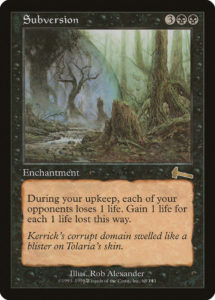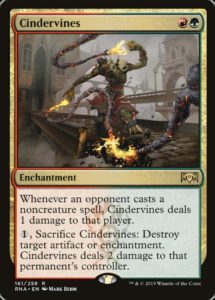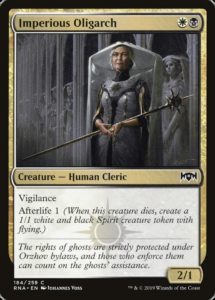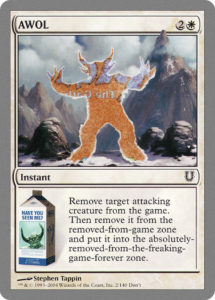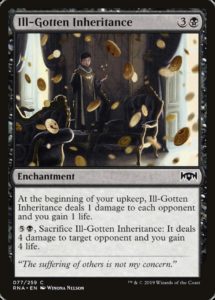There have been many life-draining cards in Magic’s history. Drain Life is perhaps the most classic example. The entire Extort mechanic was entirely about killing one’s opponents with a single prick of blood at a time. However, there’s never been a card quite like Ill-Gotten Inheritance.
Previous Precedents
Usually, cards like Ill-Gotten Inheritance are awful. Card like Subversion are slow and don’t provide board presence or card advantage—the same applies to Soul Feast and Kiss of Death. They’re lose-slower cards instead of actual win conditions.
Generally, cards that drain life from players circumvent their lack of impact by doing two very different things. Absorb Vis is first and foremost a way to fix your mana, but every now and then it can finish them off or provide you a necessary cushion of life. Blight Keeper isn’t an exciting creature, but it’s great at wearing Swashbuckling in hyperaggressive Ixalan and triggering Raid. Accursed Witch was solid in Shadows Over Innistrad Limited because it traded for a creature and then Extorted your opponent. Vampiric Feast, Soul Spike, Covenant of Blood, and Demonic Pact can go to the face but far more often kill creatures and thereby do impact the board.
The enchantments that actually were good at killing opponents were Palace Siege (which also had a second mode) and the infamous Sulfuric Vortex (which combined mana efficiency with stopping lifegain). Ill-Gotten Inheritance has none of the aforementioned benefits and looks like it should stand alongside cards like Curse of the Pierced Heart, Ajani’s Mantra, and Triskaidekaphobia as simply not good enough.
But it is good enough. Ill-Gotten Inheritance is a surprisingly strong card in Ravnica Allegiance Limited. It does so without deviating from doggedly draining your opponent. It’s strong even though apparently better cards like Eyes Everywhere (which provides virtual card advantage and a Confiscate with a hefty downside that can sometimes be reversed) are merely fine. So, let’s get to the three reasons which make Ill-Gotten Inheritance more than meets the eye.
It Complements Itself
As mentioned previously, a card that only drains life from players tends to only be good if it has another option. Well, Ill-Gotten Inheritance does have another option. Sure, Subversion and Kiss of Death are weak cards by themselves and do the same kind of thing. Stapled together, they shouldn’t fare much better, but they reinforce what each other does. A consistent source of small damage is a much better use for your mana than letting a six drop rot in your hand, waiting for your opponent to play into it (or deploying it early and letting them know exactly how much life they actually have). And an expensive, eight point life-swing means that you only need to drain your opponent down to four to kill them, not zero. That is a massive jump forward in time.
Grind and Greed are Good
Ravnica Allegiance seems a fairly slow format. Rakdos aggro is nowhere near as potent as Boros aggro was in Guilds of Ravnica. Rakdos can stall out, stuck with an army of X/2s that trade unfavorably with Imperious Oligarch, and Sage’s Row Savant or get embarrassed by Faerie Duelist. With the fun police stymied by weak creatures and powerful removal, board stalls become more prevalent and players are encouraged folks to play ever slower and bigger decks.
These factors make Ill-Gotten Inheritance better for aggro, which needs more help burning out opponents than a single Skewer the Critics can provide. It also makes the card solid in control, since the longer the game goes, the more value Ill-Gotten Inheritance accrues. I have played long, grindy games where a single Ill-Gotten Inheritance did all twenty damage by itself.
It’s also worth noting that Ill-Gotten Inheritance is not a fantastic Spectacle enabler. Sure, it turns Spectacle on, but the strength of Hackrobat Spikewheel Acrobat is deploying them early to apply pressure alongside other sources of damage (i.e. creatures), not after turn five once your opponent has had a chance to stabilize.
The Absence of Answers
Ravnica Allegiance is rife with powerful enchantments. High Alert is a sweet build-around whose ancestors were almost always relegated to rare and therefore never could do much in Limited. Dovin’s Acuity is a new, neat build-around. Rhythm of the Wild and Angelic Exaltation make your creatures even deadlier. Lawmage’s Binding is a top-tier common removal spell. And yes, there’s Ethereal Absolution and its (less insane, but still crazy powerful) friends, Theater of Horrors and Captive Audience.
However, there’s only one Disenchant effect in the entire format, Expose to Daylight. The higher rarities offer Mortify, Sunder Shaman (which basically needs your opponent’s permission to Naturalize something), Cindervines, and the world’s worst Beast Within and perhaps most uninformative Story Spotlight card, Rampage of the Clans.
I’ve wagered that the dearth of enchantment interaction was intentional on the part of Play Design. After all, plentiful enchantment removal would render all these cool enchantments (build-arounds and generally powerful) much, much worse. It could have been inadvertent, as evidenced by Mark Rosewater’s surprise. But whatever the cause, the result is that all enchantments in RNA are better than they’d normally be, and that rising tide lifts Ill-Gotten Inheritance‘s ship as well.
How’s the Design?
I love Ill-Gotten Inheritance. It so obviously should be bad and yet it proves that you can staple two nearly identical weak effects to each other and create a sum greater than the parts. It teaches a lesson about card evaluation and how small changes in both design and context can create drastically different cards and formats. It hearkens back to Extort, one of my favorite mechanics of all time because it’s so simple, so deviously potent, and so perfectly Orzhov. It demonstrates that complexity at common has gone up a bit, since we don’t often see the upkeep referenced or recurring effects at common.
Frankly, the only complaint I have about the card is the tension between its flavor and function. Slowly draining the life out of an opponent feels more like taxation or a cruel Orzhov religious ritual than a rich kid mooching off their family until they die or are murdered and the kid inherits everything. That said, Winona Nelson’s artwork is gorgeous and certainly communicates a cruel child somehow magically stealing wealth.
And that’s all I’ve got to say about this one card. As always, I’d like to remind all Magic enthusiasts and budding game designs just how much can be learned from a single card. Every card has an inspiration, ancestors, a context, and cards to be compared to. Especially simple commons that seem like they’ve been done before. I encourage you all to pick a card, any card, and consider: what is this card? How did it come to be? Why is it the way that it is? Do the parts fit together? Reinforce each other? Building understanding is both part of good game design and part of living well and you can do that just by looking at your favorite Magic card.
And, as always, thanks for reading.
—Zachary Barash is a New York City-based game designer and the commissioner of Team Draft League. He designs for Kingdom Death: Monster, has a Game Design MFA from the NYU Game Center, and does freelance game design. When the stars align, he streams Magic.
His favorite card of the month is Coat With Venom. It does a whole lot for a single mana and heralded the design of many more flexible combat tricks. Plus, it’s a solid combat trick that neither cantrips nor provides a massive power buff, which is hard to do.

